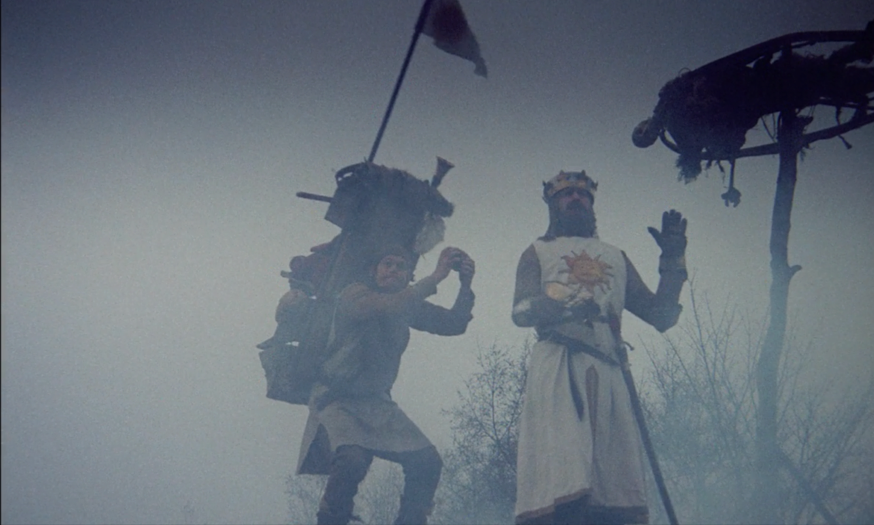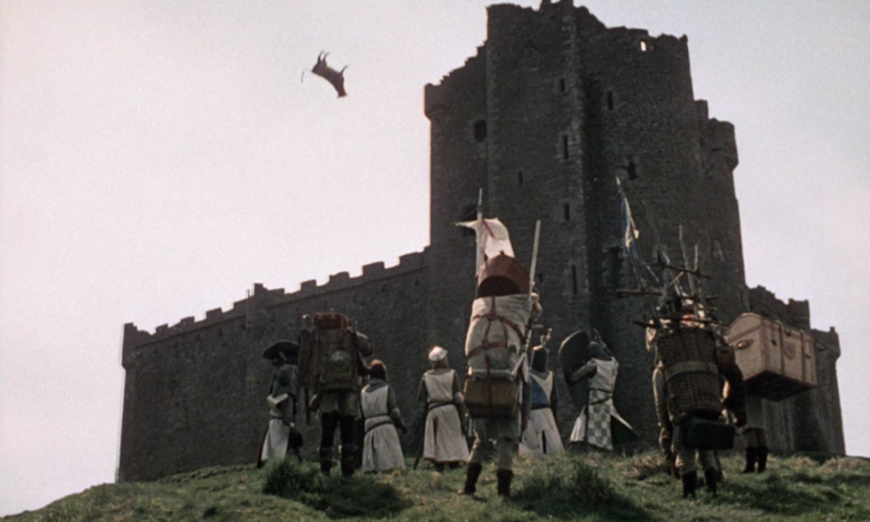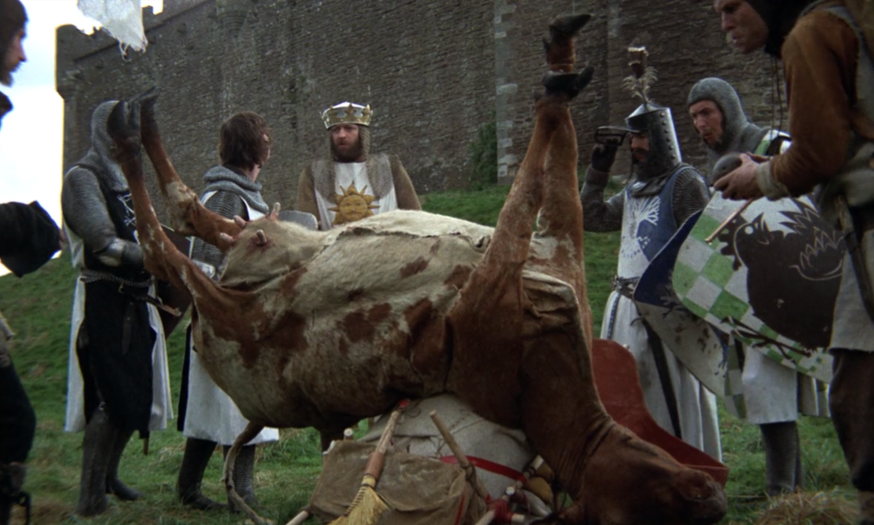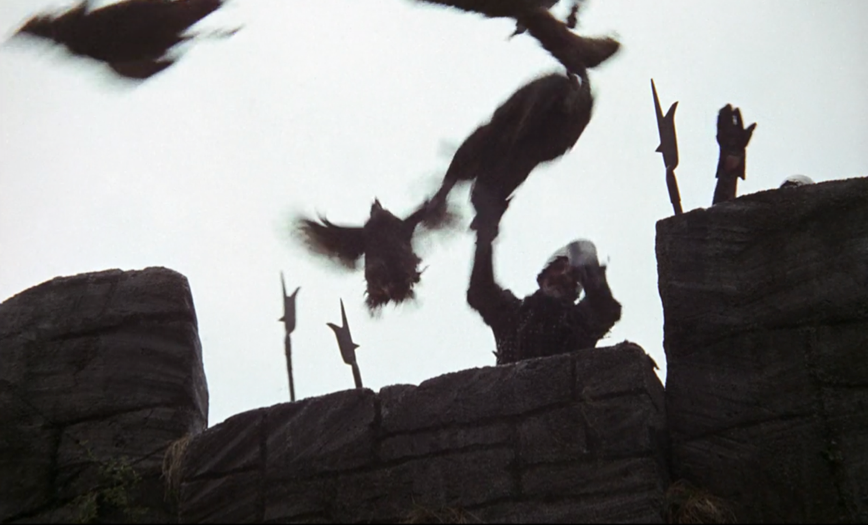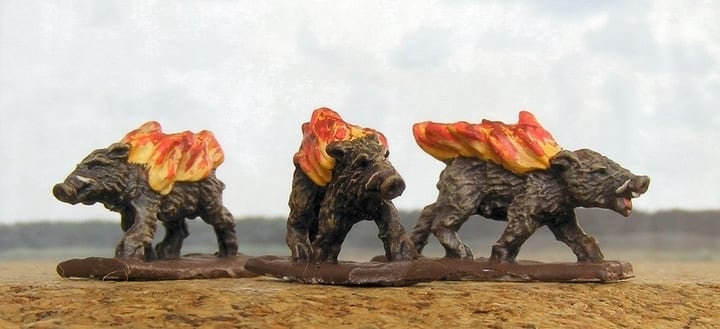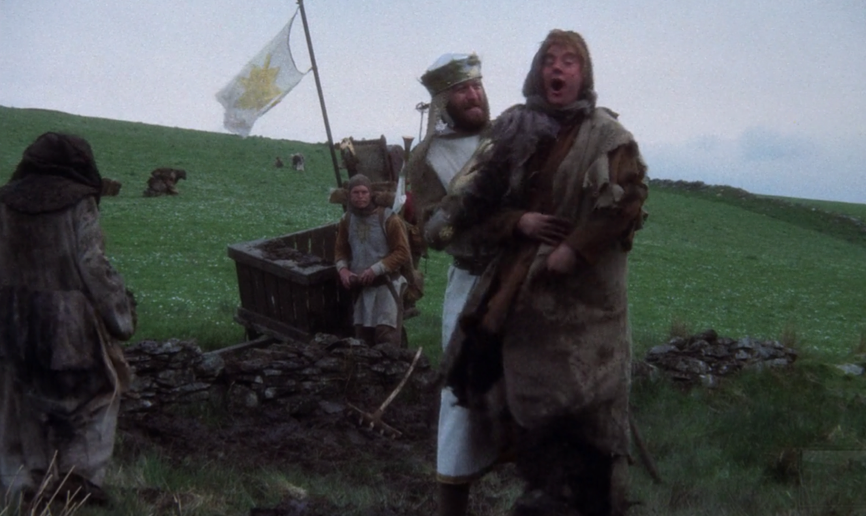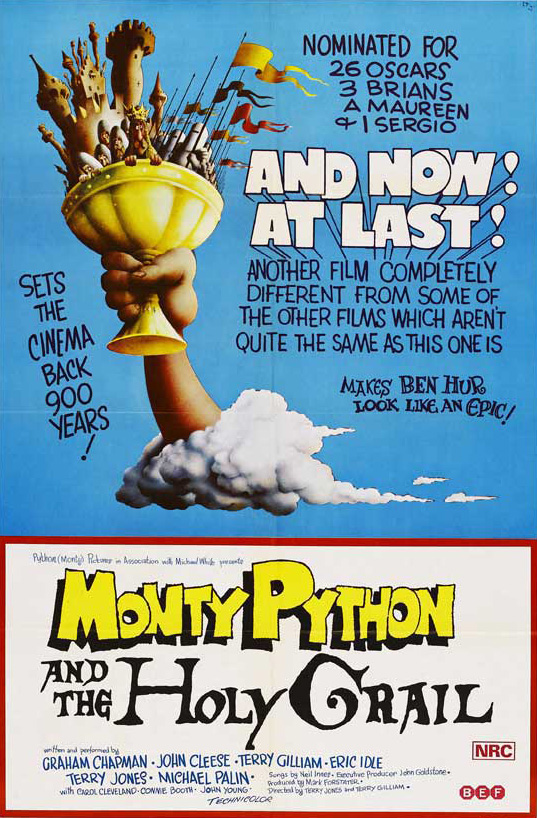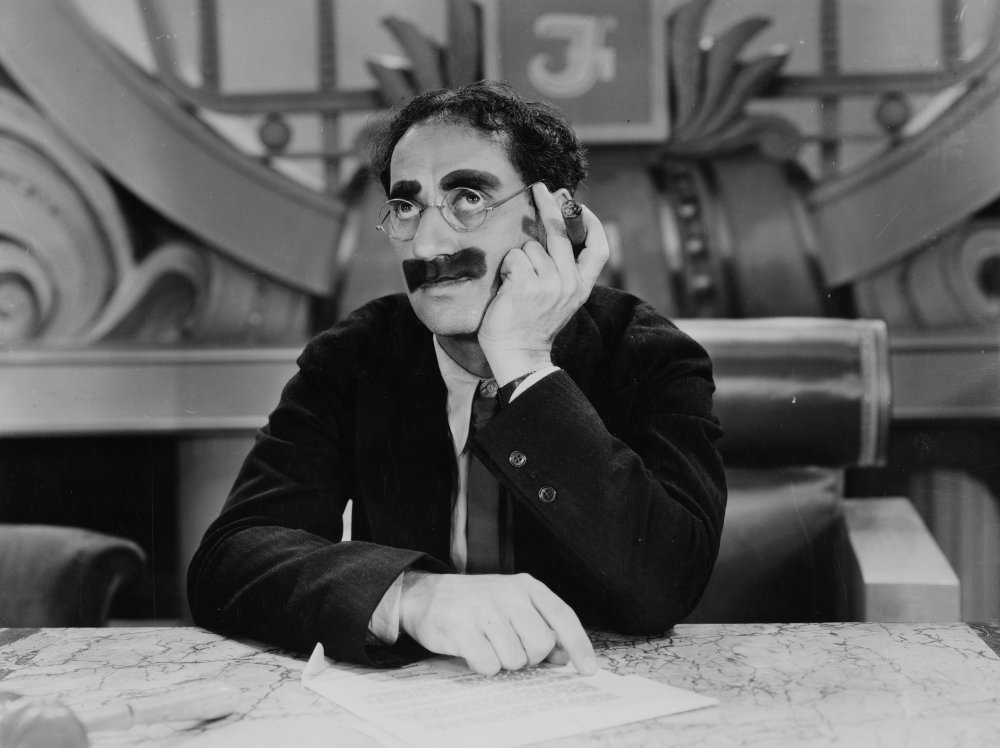In the opening scene of Monty Python and the Holy Grail [1], a grassy hill is shown with the sound of horse’s hooves—only for a skipping King Arthur, and coconut-clomping servant to appear, sans horse. This sets the scene for the finest ever cinematic use of imaginary horses.
This is the first of three feature films from the ‘Pythons’, and the Arthurian plot is effectively a vehicle for their absurd skits and satirisms. The film sees King Arthur recruit somewhat hapless knights and are commanded by God, who is the spit of W.G. Grace, to seek out the Holy Grail. Aside from the animated sequences, the film is stylistically earthy and grimy and feels quite tangible, which is important in terms of how the animalistic portrayals rub up against the absurdism of the script.
The overlapping film genres of Satire, Parody and Farce largely had their genesis in Chaplin’s highly esteemedThe Great Dictator, in which a Jewish man is mistaken for an Adolf Hitler proxy. This enables a Bakhtinian reversal of roles, so that the absurdity of fascism (in this case) can be more clearly examined and mocked. [2] This, to some degree, provides the framework for the Pythons’ first two feature films. It is arguable that the idea of an unwitting doppelgänger is lifted wholesale in The Life of Brian, but equally the Pythons’ Arthur appears far removed from the public’s imagination of him as a historical figure. This genre allows the film to use a Bakhtinian carnivalesque upending of the knights’ status, and their reputations within popular culture—Sir Bedivere the Wise is an idiot, Lancelot is bloodthirsty, Galahad horny, and so on. This arch genre, and historical timeframe allows for a re-examination of the status of animal agriculture and working animals. Many scenes in the film have incidental uses of animals, seemingly as means of plot progression. There is a very sketch-like feel to the film, and the visual trope of the animals as means for the downfall of particular characters is unmissable. Human characters are substitutes for animals, whereas animals are the means for which the humans oppress other humans.
The aforementioned opening is on a misty mound, in which Graham Chapman’s Arthur, playing it extremely straight, holds a hand up to instruct his page, Patsy, to halt the ‘horse’. He is comically overloaded. As well as providing the clomping sound of the hooves, he is heavily laden with all of Arthur’s quest gear: he is literally a proxy for a pack horse. Many of the stylistic decisions and innovations were dictated by its meagre budget (reportedly around $400,000), but the visual rhetoric of the film exists separately to this: there is therefore meaning in the ‘imaginary’ horses. This is more apparent in the later scene in which Frank, a ‘Famous Historian’, shooting a documentary about the Arthurian legend, is slaughtered by one of the knights whilst on an actual horse. Furthermore, in the ‘Bring Out Your Dead’ scene, the cart that is used for carrying corpses is pushed by poor people, and Eric Idle’s character actually strikes the man pushing the cart with a stick, as if spurring on a horse. The human characters are repeatedly brutalised in matter-of-fact ways, and they accept these circumstances. It suggests an animalisation of the medieval human experience.
Arthur and Patsy ride up to Swallow Castle where the lack of actual horse is interrogated by the two guards on the castle wall. They are therefore positioned higher than he is, and the camera shots indicate this by using shot-reverse shot to demonstrate their positions: this is a visual clue that the film will be upending the literary and historical status of the Arthurian myth. This allows a lowly guard to debate Arthur about the origin of the ‘horse’ coconut. An exchange follows regarding the origin of the coconut in which Arthur suggests that a ‘swallow could grip it by the husk’, and the guards continually rebuke his answers, ‘It’s not a question of where he grips it. It’s a simple question of weight ratios.’ The film repeatedly offers the lower classes opportunity for debating and discoursing with the upper classes. This animal therefore represents an equal reference point at which both lower and upper class can partake in the same discourse. Absurd comedy frequently invokes Raskin’s Theory of Humour, in that for a comic interaction to take place there has to be a disparity of scripts, that is, the conversational frame from which the participant derives their utterances. [3] The humour comes from the disparity between Arthur’s ‘king-to-servant’ script and the guard’s ‘philosopher-to-philosopher’ script. This is another way in which the class differences are elided and subverted.
Patsy is later injured by a projectile cow, before being flattened by a catapulted wooden rabbit. The knights run away in both instances, and it is the lower status Patsy who suffers the consequences of the Frenchmen’s violence. The scene denotes the great losses of the Hundred Years War, the victims of such would have largely been lower class soldiers, and peasants and non-combatants were also ‘targeted directly because of the connection between taxation (paid chiefly by the peasantry) and military defence’. [4] Though seemingly anachronistic, ahistorical elements, such as the Black Death scene (the film is set in 932 AD whereas the Black Death pandemic was in the 14thCentury) suggests that the film coalesces various historical moments to this particular point in time. In Animals on Film, Jonathan Burt cites Sir Robert Gower’s 1937 speech that reflects on how ‘the misuse of animals in films [is considered] more distasteful than the misuse of men.’ [5] The actor who is asked to endanger his life has the option of refusing and making the studio hire a stand-in or double. But the animal has no choice.’
The film plays upon that dynamic, by using animals as literal weapons, and means by which human characters are injured or come to harm. The projectile cow and the poultry represent something different in cultural terms than non-agricultural industry animals. Other animal models are thrown, but they are indistinct, and therefore not that helpful in determining its visual rhetoric. Arguably poultry are of lower status, as expendables within a factory farming system, therefore the subjugated role of the animal is reflected in those humans who are harmed. The animals are being stripped of their animality, not so that they can be anthropomorphised, but so that all agency and independent entity is removed.
The film is therefore concerned with the violence of oppressive systems, which is why an absurdist lens is used to highlight the arbitrary nature of it. The animals in the film, if not erased entirely, like Arthur’s horse, are often substituted by stand-in props (in an ironic reversal of studio norms), and no effort has been made to hide this. The cow that flattens Arthur’s page is clearly fake: it does not move at all in flight, its obvious artificiality is the joke. Interestingly, the chickens and fowl that the Frenchmen hurl at the Knights as a sort of poultry artillery, are real and live. Though the practicalities of movie production may have dictated it, the optics of the film results in a different emphasis on the role of the ‘working animal’ such as the horse and the cow (at least if used for dairy) and those which are destined for the slaughterhouse, such as poultry. There is actually some historical basis for the use of animals as weapons.
Pliny the Elder reported that during the 266 BC siege of Megara, the Megarans used incendiary pigs, then drove them towards the besiegers’ elephants, who would then flee and trample the enemy. [6] The film shows such awareness in its cultural (‘Bring out your dead’ is a nod to Ken Russell’s The Devils) and historical references that it seems unlikely that this was a coincidence.
The class issue is brought to the forefront by the mud dwelling Dennis the Peasant, who demonstrates, through the absurdist anachronism of anarcho-syndicalist politics in the middle-ages, that the film is making a comment—literally, he says: “Come and see the violence inherent in the system!”— on the interweaving of class and violence. The clincher is, this absurdist lens allows genuinely awkward questions to be asked of modern-day power structures. It is impossible to read this scene as a throwaway sketch when the entirety of the film is exploring the working-class repercussions of unchecked power. The beauty of this scene is that the deadpan comedy, and his animal-like existence—both in terms of his living and working in mud, and his anarchistic refusal to accept power structures— allows the film to directly address the bloodied and hypocritical history of the British Empire without appearing sanctimonious or dogmatic.
Dennis literally says:
‘King eh? Very nice. How did you get that? By exploiting the worker. By hanging on to outdated imperialist dogma, which perpetuates the economic and social differences in our society’.
Dennis, as a subject of a King and a monarchy and/or feudal system that he knew nothing of (‘well I didn’t vote for you’), is therefore subject to the same exploitative relationship as animals. In showing that he literally spends most of his days farming mud, the film parallels his existence to that of a pig, and through his unexpectedly astute philosophy (‘You can’t expect to wield supreme executive power just because some watery tart threw a sword at you!’) throws implied questions regarding the welfare and independence of farm animals. As, like many characters in the film, he is a surrogate for an animal. The class difference is a direct parallel for the species difference between Dennis and the animal that he represents. The film is commenting on both issues at the same time.
The film puts at the forefront an equivalence between the working-class and animality, by inverting the assumptions we make about both. The equation works thus: the working classes are useful in that their taxes help sustain the ruling classes; animals are useful for both food and for work. Therefore, the working-class human and animal are on a similar level in terms of how useful they are to the state. The class system and arbitrary use of executive power is safely probed behind absurdist satire, but it is also human-animal relations which are being reconfigured and examined in the film. The film not only probes the ethics of treating humans like animals, but how we treat animals themselves. The film’s animals are considered as tools for the oppression of, and violence against other humans. Even tangentially they are used for subjugation of the masses, for example, the scene in which the witch is condemned by virtue of the fact that she weighs the same as a duck. One could examine the film from a feminist position, but even in terms of power disparity, she is defeated by the films absurdist continuation of logic to its (il)logical conclusion. Each iterative statement that Sir Bedivere makes is seemingly reasonable, yet it is only the conclusion (ducks float, therefore ducks weigh the same as witches) which is ridiculous. Therefore, the visual of the duck (which, to underline its inherent wrongness, is in fact a goose) is used to highlight the absurd ways in which the powerful oppress. It is, after all, Arthur who suggests the duck.
Monty Python and the Holy Grail sits in the canon of absurdist films which use the genre in order to demonstrate the arbitrary and fragile status of socio-economic, or tyrannical power structures. It follows the tradition of other movies such as The Marx Brothers’ Duck Soup, Chapin’sThe Great Dictator, and even Kubrick’sDr. Strangelove. Animal representation in the film is used as an analogue for the mistreatment of the lower classes, in the way that they are primarily used as means for the killing or severe injury of those who follow Arthur. There is an argument to be made as to whether the substitution of the human servant for the pack-horse is a degradation of the human or an elevation of the horse. In either case, the absence of a horse, other than in the slaughtering of the historian, shows the lack of agency or individualisation of the animal image within the film.
[1] Monty Python and the Holy Grail, dir. by. Terry Gilliam and Terry Jones (United Kingdom: EMI, 1975).
[2] Mikhail Bakhtin, Rabelais and His World (Indiana: Indiana University Press, 1984).
[3] Victor Raskin, ‘Semantic Mechanisms of Humor’, In Proceedings of the Fifth Annual Meeting of the Berkeley Linguistics Society, 1979, 325–35 https://www.google.com/url?sa=t&rct=j&q=&esrc=s&source=web&cd=1&ved=2ahUKEwj4kanp25DgAhXzsHEKHVwbDA4QFjAAegQIAxAC&url=https%3A%2F%2Fjournals.linguisticsociety.org%2Fproceedings%2Findex.php%2FBLS%2Farticle%2Fdownload%2F2164%2F1934&usg=AOvVaw2E_Y0Z4r_mxUlV-Au3Aaiv.
[4] David Green, ‘7 Facts about the Hundred Years’ War’, History Extra, 2015 https://www.historyextra.com/period/medieval/7-facts-about-the-hundred-years-war/ [accessed 28 January 2019].
[5] Jonathan Burt, Animals on Film (London: Reaktion Books, 2002).
[6] Adrian Burrows, ‘Could a War Pig Really Defeat a War Elephant? – Amazing History’, History Is Now Magazine, 2014.
Bibliography
Bakhtin, Mikhail, Rabelais and His World (Indiana: Indiana University Press, 1984)
Burrows, Adrian, ‘Could a War Pig Really Defeat a War Elephant? – Amazing History’, History Is Now Magazine, 2014
Burt, Jonathan, Animals on Film (London: Reaktion Books, 2002)
Monty Python and the Holy Graildir. Gilliam, Terry, and Terry Jones (United Kingdom: EMI, 1975)
Green, David, ‘7 Facts about the Hundred Years’ War’, History Extra, 2015 https://www.historyextra.com/period/medieval/7-facts-about-the-hundred-years-war [accessed 28 January 2019]
Raskin, Victor, ‘Semantic Mechanisms of Humor’, In Proceedings of the Fifth Annual Meeting of the Berkeley Linguistics Society, 1979, 325–35 https://www.google.com/url?sa=t&rct=j&q=&esrc=s&source=web&cd=1&ved=2ahUKEwj4kanp25DgAhXzsHEKHVwbDA4QFjAAegQIAxAC&url=https%3A%2F%2Fjournals.linguisticsociety.org%2Fproceedings%2Findex.php%2FBLS%2Farticle%2Fdownload%2F2164%2F1934&usg=AOvVaw2E_Y0Z4r_mxUlV-Au3Aaiv
Further Reading
Duck Soup dir. McCarey, Leo (USA: Paramount Pictures, 1933)
The Great Dictator dir. Chaplin, Charlie, (United Artists, 1940)
Landy, Marcia, ‘Comedy, Theatricality, and Counter-History’, in Cinema and Counter History(Indiana: Indiana University Press, 2015), pp. 70–122
Pick, Anat, Creaturely Politics (New York: Columbia University Press, 2011)
